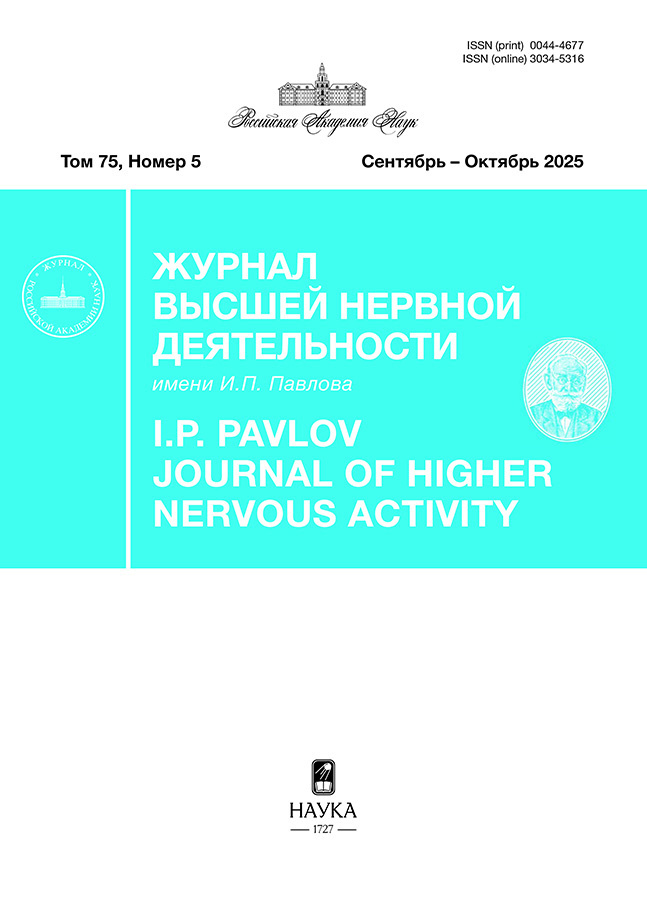Interval inhalation application of an oxygen-helium mixture reverses the effects of cerebral arterial air embolism
- Authors: Palikov V.A.1,2, Pavlov N.B.1, Ismailova A.M.2, Amirov R.R.1, Dyachenko I.A.2, Borozdina N.A.2, Bervinova A.V.2, Logunov A.T.3, Murashev A.N.2, Baranov V.M.1
-
Affiliations:
- Institute of Biomedical Problems of the Russian Academy of Sciences
- Branch of the Shemyakin-Ovchinnikov Institute of Bioorganic Chemistry, Russian Academy of Sciences
- Closed joint stock company «Specialized Design Bureau of Experimental Equipment at the Institute oof Medical and Biological Problems of the Russian Academy of Sciences»
- Issue: Vol 74, No 5 (2024)
- Pages: 632-637
- Section: ФИЗИОЛОГИЧЕСКИЕ МЕХАНИЗМЫ ПОВЕДЕНИЯ ЖИВОТНЫХ: ВОСПРИЯТИЕ ВНЕШНИХ СТИМУЛОВ, ДВИГАТЕЛЬНАЯ АКТИВНОСТЬ, ОБУЧЕНИЕ И ПАМЯТЬ
- URL: https://cardiosomatics.orscience.ru/0044-4677/article/view/652075
- DOI: https://doi.org/10.31857/S0044467724050072
- ID: 652075
Cite item
Abstract
Oxygen-helium mixture demonstrates marked efficacy of helium mixtures in animal models of ischemia/reperfusion, which opens the possibility of its use as an emergency measure for therapy of vascular embolism. We modelled cerebral arterial air embolism by injecting an air bubble into the internal carotid artery of awake rats. Inhalation of a heated oxygen-helium mixture immediately after modelling arterial embolism normalizes physiological abnormalities and prevents ischemic brain damage, whereas application of a heated oxygen-helium mixture 2 hours after modelling arterial embolism significantly worsens the condition of the animals.
Full Text
About the authors
V. A. Palikov
Institute of Biomedical Problems of the Russian Academy of Sciences; Branch of the Shemyakin-Ovchinnikov Institute of Bioorganic Chemistry, Russian Academy of Sciences
Email: baranov-vm@mail.ru
Russian Federation, Moscow; Pushchino
N. B. Pavlov
Institute of Biomedical Problems of the Russian Academy of Sciences
Email: baranov-vm@mail.ru
Russian Federation, Moscow
A. M. Ismailova
Branch of the Shemyakin-Ovchinnikov Institute of Bioorganic Chemistry, Russian Academy of Sciences
Email: baranov-vm@mail.ru
Russian Federation, Pushchino
R. R. Amirov
Institute of Biomedical Problems of the Russian Academy of Sciences
Email: baranov-vm@mail.ru
Russian Federation, Moscow
I. A. Dyachenko
Branch of the Shemyakin-Ovchinnikov Institute of Bioorganic Chemistry, Russian Academy of Sciences
Email: baranov-vm@mail.ru
Russian Federation, Pushchino
N. A. Borozdina
Branch of the Shemyakin-Ovchinnikov Institute of Bioorganic Chemistry, Russian Academy of Sciences
Email: baranov-vm@mail.ru
Russian Federation, Pushchino
A. V. Bervinova
Branch of the Shemyakin-Ovchinnikov Institute of Bioorganic Chemistry, Russian Academy of Sciences
Email: baranov-vm@mail.ru
Russian Federation, Pushchino
A. T. Logunov
Closed joint stock company «Specialized Design Bureau of Experimental Equipment at the Institute oof Medical and Biological Problems of the Russian Academy of Sciences»
Email: baranov-vm@mail.ru
Russian Federation, Khimki
A. N. Murashev
Branch of the Shemyakin-Ovchinnikov Institute of Bioorganic Chemistry, Russian Academy of Sciences
Email: baranov-vm@mail.ru
Russian Federation, Pushchino
V. M. Baranov
Institute of Biomedical Problems of the Russian Academy of Sciences
Author for correspondence.
Email: baranov-vm@mail.ru
Russian Federation, Moscow
References
- Министерство здравоохранения Российской федерации. Клинические рекомендации. Клинические рекомендации – Ишемический инсульт и транзиторная ишемическая атака у взрослых – 2021-2022-2023. 2021. 168 c.
- Archer D.P., Walker A.M., McCann S.K., Moser J.J., Appireddy R.M. Anesthetic Neuroprotection in Experimental Stroke in Rodents: A Systematic Review and Meta-analysis. Anesthesiology. 2017. 126 (4): 653–665.
- Fakkert R.A., Karlas N., Schober P., Weber N. C., Preckel B., van Hulst R. A., Weenink R.P. Early hyperbaric oxygen therapy is associated with favorable outcome in patients with iatrogenic cerebral arterial gas embolism: systematic review and individual patient data meta-analysis of observational studies. Critical Care. 2023. 27 (1): 282.
- Li Z., Li G., Li Y., Chen Y., Li J., Chen H. Flow field around bubbles on formation of air embolism in small vessels. Proceedings of the National Academy of Sciences of the United States of America. 2021. 118(26):e2025406118.
- Pagel P.S., Krolikowski J.G., Shim Y.H., Venkatapuram S., Kersten J.R., Weihrauch D., Warltier D.C., Pratt P.F. Jr. Noble gases without anesthetic properties protect myocardium against infarction by activating prosurvival signaling kinases and inhibiting mitochondrial permeability transition in vivo. Anesth Analg. 2007. 105 (3): 562–569.
- Palikov V.A., Pavlov N.B., Amirov R.R., Ismailova A.M., Borozdina N.A., Palikova Y.A., Dyachenko I.A., Khokhlova O.N., Ponomareva T.I., Rykov V.A., Logunov A.T., Murashev A.N., Baranov V.M. Effect of a helium and oxygen mixture on physiological parameters of rats with cerebral arterial air embolism. Frontiers in physiology. 2024. 15: 1388331.
- Pan Y., Zhang H., Acharya A.B., Cruz-Flores S., Panneton W.M. The effect of heliox treatment in a rat model of focal transient cerebral ischemia. Neurosci Lett. 2011. 497 (2): 144–147.
- Pan Y., Zhang H., VanDeripe D.R., Cruz-Flores S., Panneton W.M. Heliox and oxygen reduce infarct volume in a rat model of focal ischemia. Exp Neurol. 2007. 205 (2): 587–90.
- Randhawa A.S., Pariona-Vargas F., Starkman S., Sanossian N., Liebeskind D. S., Avila G., Stratton S., Gornbein J., Sharma L., Restrepo-Jimenez L., Valdes-Sueiras M., Kim-Tenser M., Villablanca P., Conwit R., Hamilton S., Saver J.L. Beyond the Golden Hour: Treating Acute Stroke in the Platinum 30 Minutes. Stroke. 2022. 53 (8): 2426–2434.
- Wang Q., Zhang X., Suo Y., Chen Z., Wu M., Wen X., Lai Q., Yin X., Bao B. Normobaric hyperoxia therapy in acute ischemic stroke: A literature review. Heliyon. 2023. 10 (1): e23744.
- Zhong W., Cheng J., Yang X., Liu W., Li Y. Heliox Preconditioning Exerts Neuroprotective Effects on Neonatal Ischemia/Hypoxia Injury by Inhibiting Necroptosis Induced by Ca2+ Elevation. Transl Stroke Res. 2023. 14 (3): 409–424.
Supplementary files













